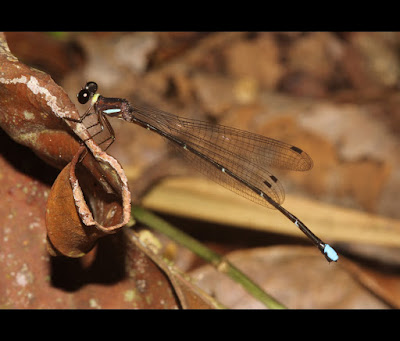[Most Recent Entries] [Calendar View]
Wednesday, November 2nd, 2016
| Time | Event | ||
| 6:09a | [Entomology • 2016] Taxonomy and Molecular Phylogeny of the Platystictidae (Insecta: Odonata) of Sri Lanka
Abstract The 22 Sri Lankan representatives of the family Platystictidae, all endemic to the island and belonging to the distinct endemic subfamily Platystictinae, are revised, and a new reconstruction of the phylogeny based on molecular characters is provided. Five new species are described: Ceylonosticta venusta sp. nov. (holotype ♂: Rambodde Falls, at the tunnel; Nuwara Eliya District, Central Province; N7.0489, E80.6961; 12-vii-2012; to be deposited at National Museum of Natural History, Colombo, Sri Lanka), Ceylonosticta inferioreducta sp. nov. (holotype ♂: Norton Bridge, stream on the B43 road 1.5km WNW of Norton Bridge; Nuwara Eliya District, Central Province; N6.9171, E80.5075; 28-vii-2009; to be deposited at National Museum of Natural History, Colombo, Sri Lanka), Ceylonosticta mirifica sp. nov. (holotype ♂: Uwella, primary forest on the road Uwella-Ratnapura, 11.5km NW of Balangoda; Ratnapura District, Sabaragamuwa Province; N6.6968, E80.6059; 16-vii-2012; to be deposited at National Museum of Natural History, Colombo, Sri Lanka), Platysticta secreta sp. nov. (holotype ♂: Hasalaka; Kandy District, Central Province; N7.3535, E80.9509; 31-v-1975; deposited at National Museum of Natural History, Smithsonian Institution, Washington, USA) and Platysticta serendibica sp. nov. (holotype ♂: Kanneliya; Galle District, Southern Province; N6.2291, E80.3834; 8 & 9-vi-1975; deposited at National Museum of Natural History, Smithsonian Institution, Washington, USA). Additionally, a determination key, figures showing morphological details and coloration in life, as well as distribution maps for all species are presented. Based on molecular analysis of 21 taxa, the phylogeny of Platystictinae is presented and discussed from the zoogeographical and paleogeographical point of view. Sri Lankan species, traditionally placed in the genera Platysticta Selys and Drepanosticta Laidlaw / Ceylonosticta Fraser, separated into distinct clades within the subfamily as presently defined, but the monophyletic nature of the Platystictinae and its Sri Lankan endemicity is confirmed. For the South Indian species, formerly known as Platysticta deccanensis, morphological and molecular analyses demonstrated that it does not belong to the Sri Lankan clade and a new genus Indosticta gen. nov. is erected to accommodate it. Keywords: Odonata, Zygoptera, Platystictidae, Platystictinae, new species, new genus, Ceylonosticta, Platysticta, Indosticta, Sri Lanka, India M. Bedjanič, K. Conniff, R.A. Dow, F. R. Stokvis, R. Verovnik and J Van Tol. 2016. Taxonomy and Molecular Phylogeny of the Platystictidae of Sri Lanka (Insecta: Odonata). Zootaxa. 4182(1); 1–80. DOI: 10.11646/zootaxa.4182.1.1 | ||
| 9:30a | [Herpetology • 2017] Phylogeographic Structure Across One of the Largest Intact Tropical Savannahs: Molecular and Morphological Analysis of Australia’s Iconic Frilled Lizard Chlamydosaurus kingii Highlights • Genetic data from five loci show three shallow genetic clades within frilled lizards. • Clades are broadly consistent with clinal variation in frill color. • Data from 279 specimens shows only subtle morphological differentiation between clades. • Biogeographic patterns are consistent with other taxa in the Australian monsoon tropics. • Extremely low divergences suggest recent gene flow between, and extensive gene flow within, clades. Abstract The spectacular threat display of the savannah specialist Australo-Papuan frilled lizards has made them one of the world’s most iconic reptiles. They are increasingly used as a model system for research in evolutionary biology and ecology but little is known of their population structure. Their distribution across northern Australia and southern New Guinea also provides an opportunity to examine biogeographic patterns as they relate to the large-scale movement of savannah habitat during the Plio/Pleistocene and the associated increase in aridity. We generated sequence data for one mitochondrial and four nuclear DNA loci (5052 base pairs) for 83 frilled lizards sampled throughout their range. We also quantified body proportion variation for 279 individuals. Phylogenetic analyses based on maximum likelihood and Bayesian species-tree methods revealed three shallow clades that replace each other across the monsoon tropics. We found the expected pattern of male biased sexual size dimorphism in both maximum body size and head size but there was no sexual dimorphism in overall body shape or in frill size, relative to head size, supporting the hypothesis that the frill is used primarily as a threat display rather than a sexual display. The genetic clades are broadly consistent with known clinal variation in frill color that gradually shifts from west to east (red, orange, yellow/white) but otherwise show little morphological differentiation in body proportion measures. The biogeographic breaks between clades occur at the Carpentaria Gap and the lowlands surrounding the Ord River, and our ecological niche modeling predicts lower habitat suitability for Chlamydosaurus kingii in these regions. While this biogeographic pattern is consistent with numerous other taxonomic groups in northern Australia, the overall low genetic diversity in frilled lizards across the entire monsoon tropics and southern New Guinea contrasts starkly to patterns seen in other terrestrial vertebrates. Extremely low intra-clade genetic diversity over vast geographic areas is indicative of recent gene flow that would likely have been facilitated by widespread savannah during interglacials, or alternatively may reflect population bottlenecks induced by extreme aridity during Pleistocene glacials. The shallow divergence between Australian and New Guinean samples is consistent with recent connectivity between Australia and New Guinea that would have been possible via a savannah corridor across the Torres Strait. Based on our molecular and morphological data, we do not support taxonomic recognition of any of the frilled lizard clades and instead consider C. kingii a single species with shallow phylogeographic structure and clinal variation in frill color. Keywords: Monsoon tropics; Phylogeography; Trans-Fly; Torres Strait; Carpentarian Gap; Ord River Mitzy Pepper, David G. Hamilton, Thomas Merkling, Nina Svedin, Bori Cser, Renee A. Catullo, Sarah R. Pryke and J. Scott Keogh. 2017. Phylogeographic Structure Across One of the Largest Intact Tropical Savannahs: Molecular and Morphological Analysis of Australia’s Iconic Frilled Lizard Chlamydosaurus kingii. Molecular Phylogenetics and Evolution. 106; 217-227. DOI: 10.1016/j.ympev.2016.09.002 |
| << Previous Day |
2016/11/02 [Calendar] |
Next Day >> |




